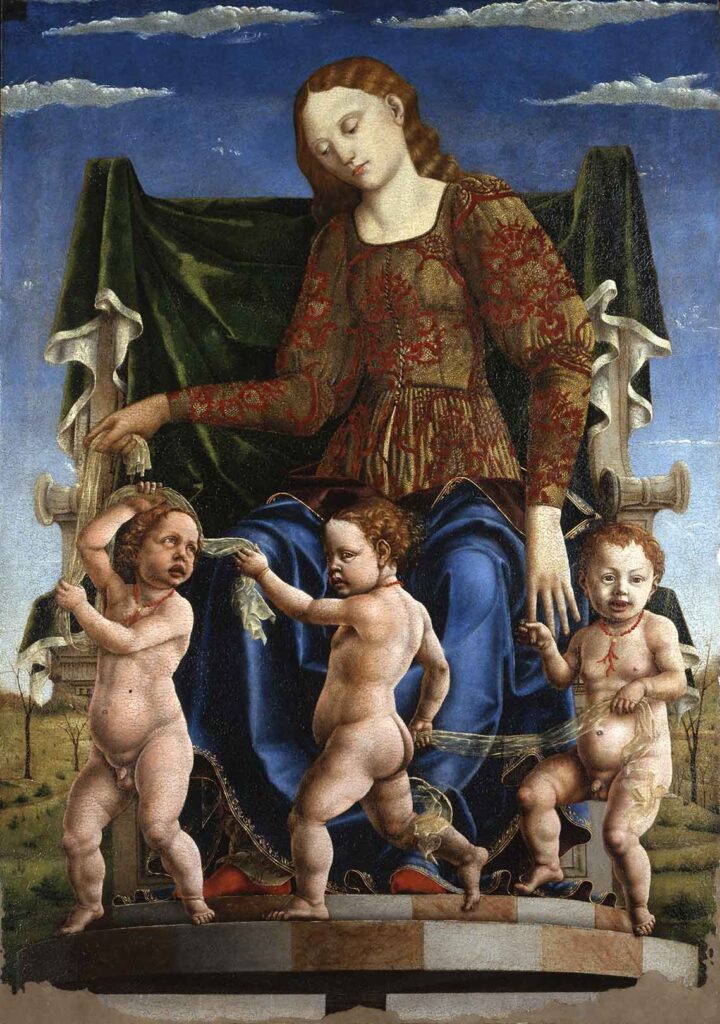The Muse Terpsichore
Angelo Maccagnino , ca. 1460
Description

The Muse Terpsichore comes from the decoration of the studiolo of the Palazzo di Belfiore near Ferrara, which was made around the mid-15th century on commission from the lords of Ferrara, Lionello and Borso d’Este. Of the cycle, which included the depiction of the nine Muses, five other female figures similar to this one are preserved at museums in Ferrara, Berlin, Budapest and London.The muse of the dance wears a rich velvet gown, in keeping with the fashion that became established in Italy from the 1550s onward.
A thick lacing, which runs down over the belly and one hip, ensures a perfect fit to the bust and is suitable for use during pregnancy. The stylistic features typical of Cosmè Tura (the major representative of the Ferrarese Renaissance school of painting) are evident in the lower part of the painting, in the dancing putti with strongly expressive faces, in the beautiful drapery of the blue mantle covering the legs of the Muse, in the red-shod feet protruding prospectively from the circular steps of the throne base, and in the two desolate landscapes, which extend deep into the painting and show a view of the barren countryside.
In the upper part of the panel, in the softened and conventional face of the Muse and in the rigidly set bust, we identify instead the hand of a different artist, perhaps the mysterious Sienese painter Angelo Maccagnino, who first received the commission for the decoration of Belfiore’s studiolo. It cannot be ruled out that Cosmè Tura, who was appointed director of the decoration of the studiolo about ten years later, actually adapted and updated an older painting.This update would also include the transformation of the pagan muse, patron of the prince’s spiritual virtues, into a sort of fertility goddess (note the open robe over the belly, alluding to motherhood), to celebrate the reclamation and canalization carried out by Borso d’Este in the Ferrara countryside.
Data Sheet
Author
Cosmè Tura, 1430 ca.-1495
Date
ca. 1460
Material and technique
Tempera on panel
Measures
117.5 cm x 81 cm
Acquisition
Gian Giacomo Poldi Pezzoli bequest, 1879
Inventory number
1559
location
Golden Room
The Golden Room is the most important room in the Museum and houses the masterpieces of painting from the Poldi Pezzoli collection. Conceived according to the dictates of the Renaissance style, it was designed to be the hall of honor of Gian Giacomo’s apartment. After the collector’s death, Giuseppe Bertini carried on the work: unfortunately, both the gilded coffered ceiling, the frescoes, painted by Bertini himself, and the damask fabric decorations that lined the walls were destroyed by bombing. The current museographic arrangement dates back to the 1990s. Among the works on display are the Portrait of a Lady attributed to Piero del Pollaiolo and which has become a symbol of the museum, Bellini’s Imago Pietatis, Botticelli’s Lamentation over the Dead Christ, Mantegna’s Madonna and Child, and Piero della Francesca’s Saint Nicholas of Tolentino. The display case separating the Salone Dorato from the Sala degli Stucchi houses the porcelain and majolica collections.
collection
Paintings
The Museum hosts over 300 paintings. Among them, many Italian works from the Renaissance: masterpieces from Tuscany (Botticelli, Piero della Francesca, Pollaiuolo), Lombardy (Luini, Boltraffio, Solario) and Veneto (Bellini, Mantegna). Important is also the group of 18th century Italian painting (Guardi, Canaletto, Tiepolo, Fra Galgario). In the collection, there are mainly portraits and small size paintings.
